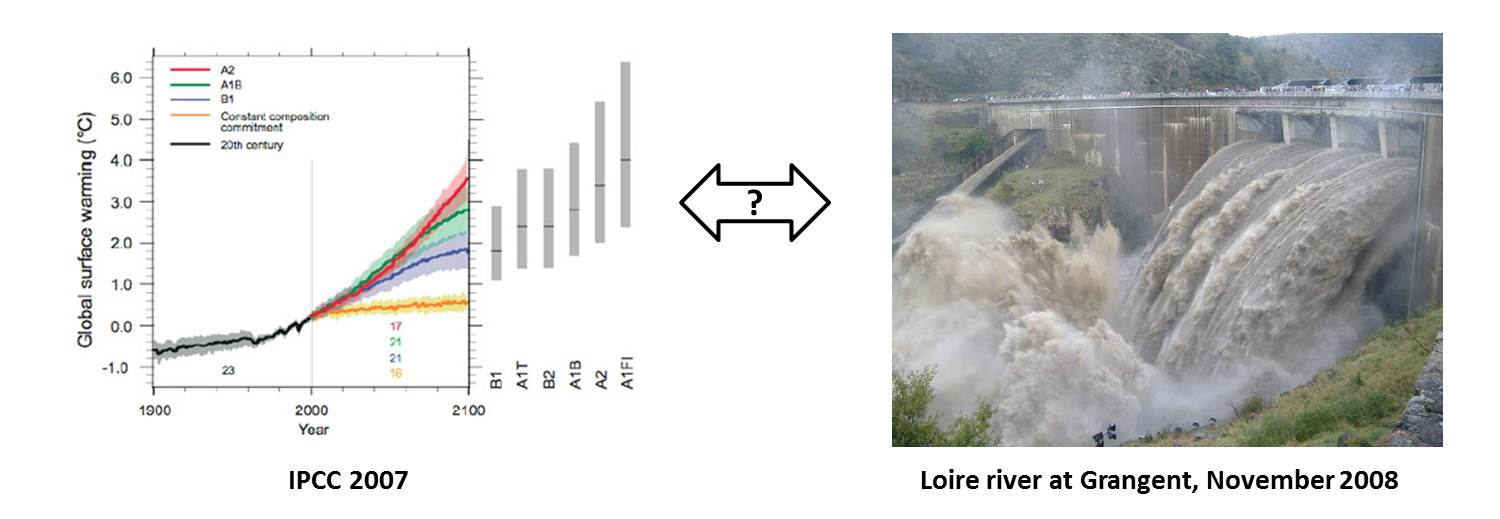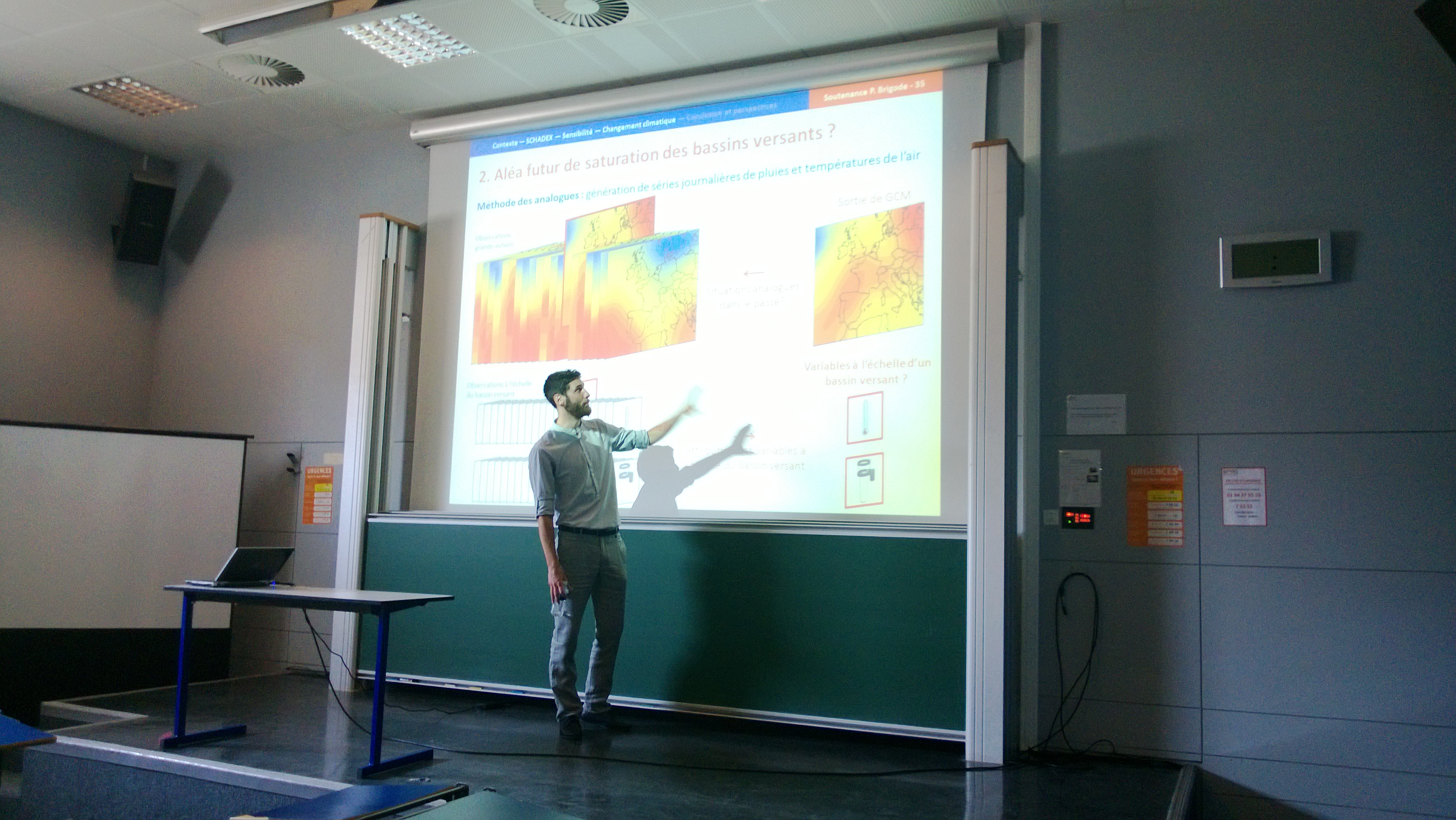- Title: Climate change and flood hazard: Evaluation of the SCHADEX methodology in a non-stationnary context.
- Defended the 11th July 2013 (CIFRE scolarship from October 2010 to September 2013).
- Collaboration between Electricité de France - R&D (Chatou, France) and UMR Sisyphe - now Métis - (Université Pierre et Marie Curie, Paris, France).
- The PDF version of the dissertation can be downloaded here and the presentation slides (in French) are available upon request.
- Winner of the CNFGG PhD thesis award, Hydrological Sciences section (CNFGG: French national comity of geodesy and geophysics).

Abstract
Since 2006, Électricité de France (EDF) applies a new hydro-climatological approach of extreme rainfall and flood predetermination - the SCHADEX method - for the design of dam spillways. In a context of potential increase of extreme event intensity and frequency due to climate change, the use of the SCHADEX method in non-stationary conditions is a main interest topic for EDF hydrologists. Thus, the scientific goal of this Ph.D. thesis work has been to evaluate the ability of the SCHADEX method to take into account future climate simulations for the estimation of future extreme floods. The recognized inabilities of climate models and downscaling methods to simulate (extreme) rainfall distribution at the catchment-scale have been avoided, by developing and testing new methodological approaches. Moreover, the decomposition of the flood-producing factors proposed by the SCHADEX method has been used for considering different simulated climatic evolutions and for quantifying the relative impact of these factors on the extreme flood estimation.
First, the SCHADEX method has been applied in present time over different climatic contexts (France, Austria, Canada and Norway), thanks to several colorations with academic and industrial partners. A sensitivity analysis allowed to quantify the extreme flood estimation sensitivity to rainfall hazard, catchment saturation hazard and rainfall-runoff transformation, independently. The results showed a large sensitivity of SCHADEX flood estimations to the rainfall hazard and to the rainfall-runoff transformation.
Using the sensitivity analysis results, tests have been done in order to estimate the future evolution of “key” variables previously identified. New climate model outputs (done within the CMIP5 project) have been analyzed and used for determining future frequency of rainfall events and future catchment saturation conditions. Considering these simulated evolutions within the SCHADEX method lead to a significant decrease of simulated extreme floods. In order to predict the future intensity of rainfall events with air temperature simulated series, tests have been performed on several hundred of French catchment rainfall series, trying to link observed air temperature with observed rainfall event intensity. The results obtained show a mean heavy rainfall intensity increase of 6% per degree of air temperature rise, at the daily timescale. Nevertheless, supplementary tests are needed in order to estimate the timestep and the temperature range at which this rainfall event intensity increase is valid. Finally, these different future evolutions have all been used as inputs of the SCHADEX method. This last test showed the difficulty to quantify the impact of climate change on extreme floods due to a combination of extreme flood decrease factors (extreme flood decrease due both to future rainfall event frequency and catchment saturation condition evolution) and extreme flood increase factor (extreme flood increase due to an increase of future rainfall event intensity ).
Even if the extreme flood estimation sensitivity analysis has raised numerous questions about the rainfall-runoff model calibration within the SCHADEX method, quantifying the future rainfall event intensity is the key question for the extreme rainfall and flood predetermination in a climate change context.
Evaluation commitee
- Pr. Hervé Le Treut, UPMC, Paris (président).
- Pr. Anne-Catherine Favre, LTHE, Grenoble (rapportrice)
- Dr. Michel Lang, IRSTEA, Lyon (rapporteur)
- Dr. Charles Perrin, IRSTEA, Antony (examinateur)
- Dr. Christel Prudhomme, CEH, Wallingford (examinateur)
- Pr. Pierre Ribstein, UPMC, Paris (directeur de thèse)
- Dr. Pietro Bernardara, EDF R&D, Chatou (encadrant de thèse)
- M. Joël Gailhard, EDF DTG, Grenoble, (invité)

Travelling
4-month stay in Vancouver (August to November 2011)
- Exchange with BC HYDRO (British Columbia electric utility).
- Definition of two British-Columbia weather pattern classifications (Coastal and Interior regions).
- Application of the SCHADEX method on three BC catchments (Campbell, Coquitlam and Colombia rivers).
- Comparison with existing results (Probable Maximum Precipitation and Probable Maximum Flood).
3-week stay in Halle (Saale), Germany (November 2012)
- Short Term Scientific Mission allowed by FloodFreq, COST ES0901 action.
- Exchange with the Helmholtz Centre for Environmental Research (UFZ) (German research Institut).
- Estimation of future extreme flood hazard on an Austrian catchment (the Kamp river at Zwettl, cf. map below) using the SCHADEX method.
- Evaluation of the analogue method for re-constructing Austrian daily precipitation series.